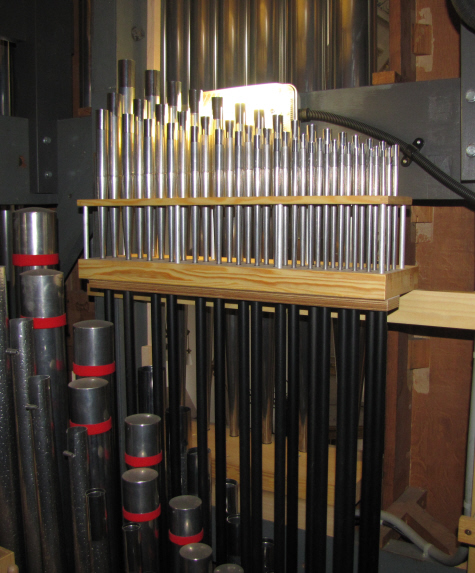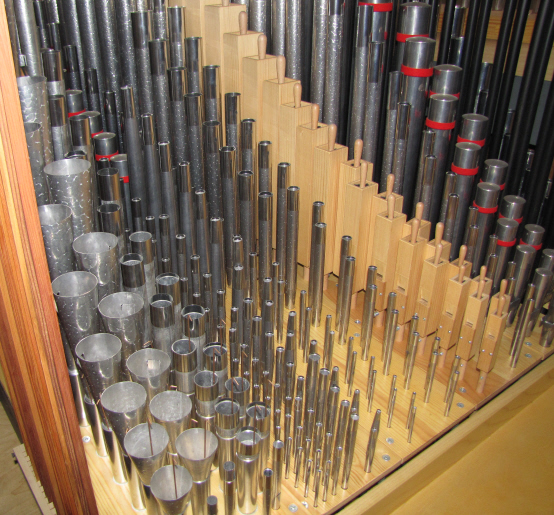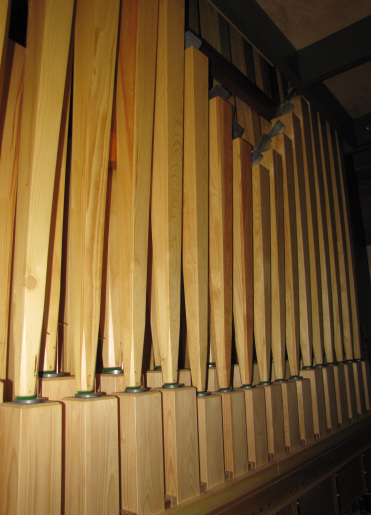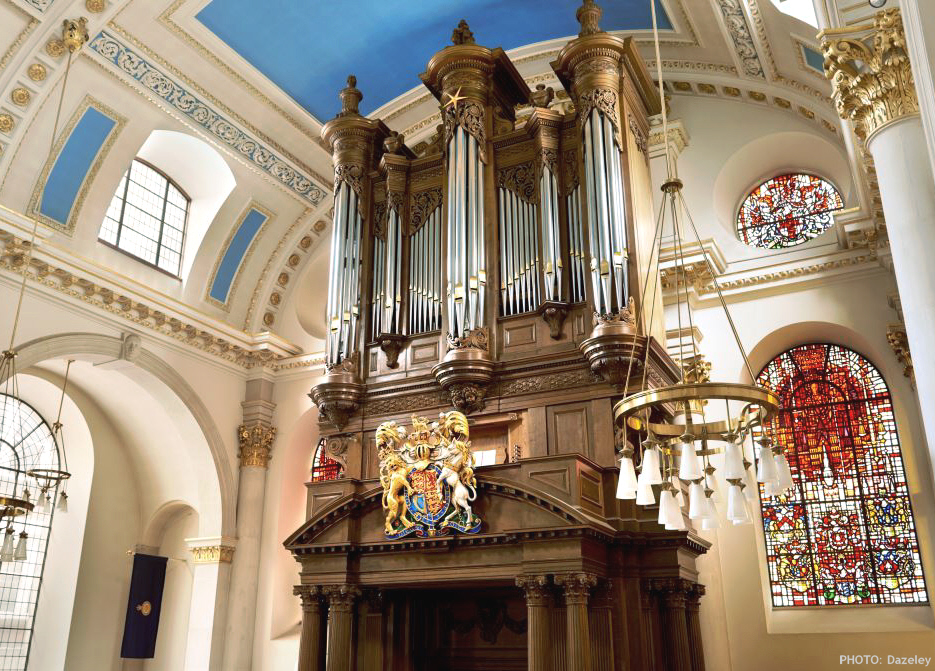St Mary-le-Bow, London
Hauptwerk (v5 and upwards) Virtual Organ
© Lavender Audio 2008 - 2024










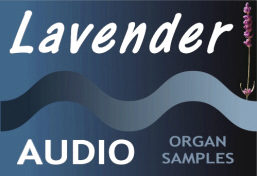
The organ is situated on a gallery at the west end of the church which itself has a reverberation time of approximately 4 seconds. Thus the apocryphal “best stop” of the organ – its location and the acoustic into which it sounds – is most favourable and somewhat unusual for a British church. The gallery is relatively shallow in depth which has resulted in the Swell organ being placed above the combined Great and Pedal soundboard, with the larger bass pipes being located behind, to the sides and in the facade. The pipework is designed to give a bright but unforced sound, operating on relatively low wind pressures. The key and pedal action is mechanical, but the stop action is electric, thus allowing for a relatively advanced level of control, with divisional and general pistons, alongside a sequencer. In part, this flexibility makes up for the fact that the instrument has just two manuals; whilst a three manual organ would have just about fitted in the available space, it would inevitably have involved various compromises.
There is one unusual addition to the specification – MIDI on Swell. This was requested by the then organist, Alan Wilson, who is a noted composer and it allows a range of electronically produced sounds to be added as desired. Incidentally, this facility has been incorporated into the standard sample set, meaning that the Swell manual MIDI output from Hauptwerk can be switched on and off from within the sample set.
A multi-microphone approach was taken, with a total of eight microphones employed in various locations. The Close perspective has been captured by microphones placed in the gallery itself, situated directly in front of the pipework to the left and right. The Ambient perspective is a blend of two stereo microphone sets, located on tall stands positioned approximately 5 metres back from the case. The Surround perspective is set another metre further away, but has microphones facing directly away from the organ to maximise the pick-up of the church acoustic. For the single-channel sample set, a careful blend of the Close and Ambient perspectives has been created, to give an optimal balance of direct and reverberant sound.
THE ORGAN AND THE HAUPTWERK SAMPLE SET
In his write-up of the organ for the Institute of British Organ Building, Kenneth
Tickell notes that “a coherent specification which can do justice to the core repertoire
of the organ should naturally have the capability for choir and congregational accompaniment
(though the reverse is not necessarily true)”.
Whilst the organ stylistically leans towards the French classical period it is certainly
the case that early English and German music also sound very well on this instrument.
The light wind pressures and unforced voicing results in stops which blend very well
with one another and there are a great variety of solo combinations, some possibly
rather unexpected. For example, one would expect to simply use the three rank Great
Cornet with the Stopped Diapason and Spitz Flute to provide the typically wide scaled
five rank cornet sound. However, adding in either the Fifteenth or even the Furniture
to this combination gives a notably different solo register which will nonetheless
have its uses. Equally, constructing the Swell cornet with the slightly flutey 4'
Principal as opposed to the Harmonic Flute will yield a different but equally musical
effect. Music of the romantic period is catered for by the provision of a decent
full swell, along with a useful Swell Oboe and undulating strings. In fact, the variety
of 8 foot stops does mean that the organ can be considered a versatile all-rounder
with probably just the more complex romantic repertoire (not to mention Tuba tunes!)
maybe being a step too far.
As an organ for accompanying choir and congregation, there is no doubt that the versatility
of tone available allows this role to be fulfilled admirably. Although in the full
organ sound, reeds and mixtures come to the fore, there is a decent amount of weight
provided by the full length Pedal Violone. More delicate choral textures can be nicely
underpinned by the softer sounds such as the flutes, the Swell strings and even the
Great Gamba which doubles as a very useful small Open Diapason.
Sustain samples of some 6 - 8 seconds duration were taken and there are three release
samples per note to take account of the difference between the sound of the release
for short (staccato), medium (portato - typically 200 to 500 mS, depending on pitch)
and long note durations. A few notes feature extra medium duration release samples,
particularly for the slower evolving lower pitched pipes. Each sustain sample features
an average of three individual loops.
There are individual tremulants for the Great and Swell; both are quite slow moving,
with the Swell tremulant more pronounced than its counterpart on the Great. The St
Mary-le-Bow sample set features both sampled and Hauptwerk modelled tremulants throughout
and the user is able to switch on a rank by rank basis between the two tremulant
choices. The Hauptwerk tremulant model allows speed, depth and various other parameters
to be adjusted, however, the sampled tremulants sound significantly more realistic,
even if they do require more computer resources when loading the set. Therefore,
the recommendation is to use the sampled tremulants, although a combination of the
two may be chosen if system memory (ie computer RAM) is at a premium.
IN USE ~ SOME SUGGESTIONS AND CONSIDERATIONS
The Great Cornet, mounted immediately behind the facade pipes
Great Organ pipework. The classically styled reeds - Trumpet and Cromorne - are to the left.
The Pedal Trombone pipes, situated to the rear of the organ.



